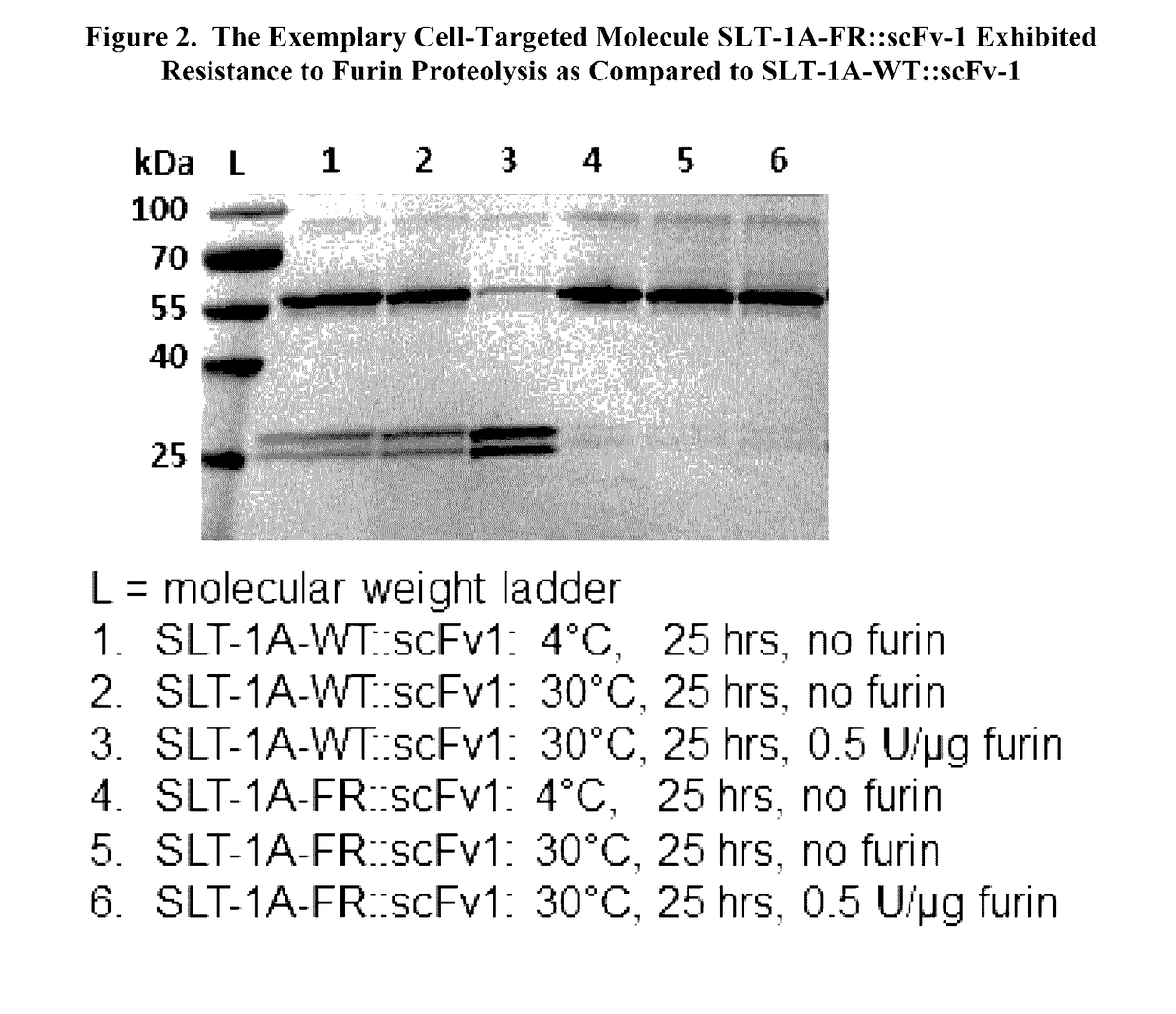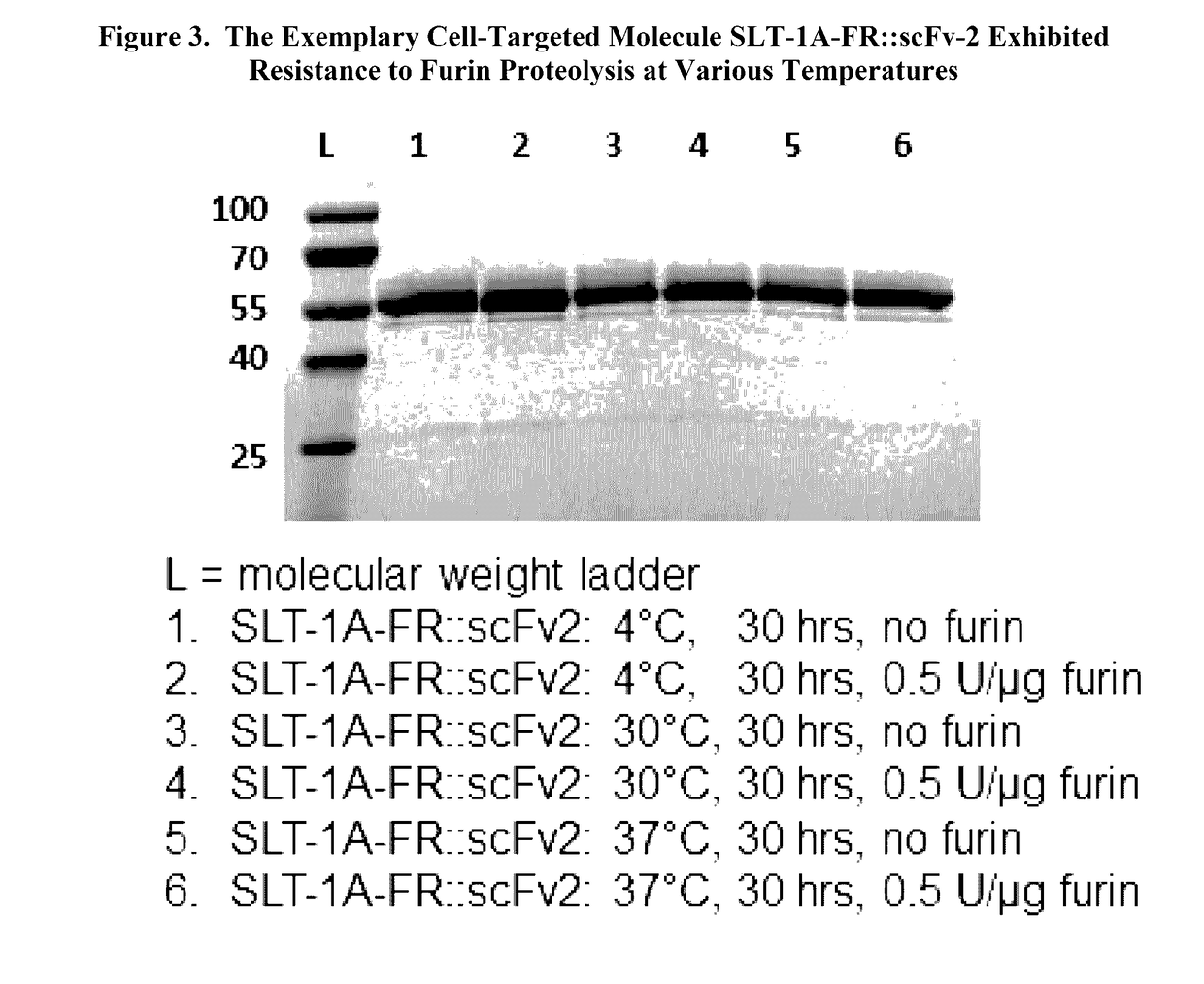Protease-cleavage resistant, shiga toxin a subunit effector polypeptides and cell-targeted molecules comprising the same
a technology of shiga toxin and effector polypeptides, which is applied in the direction of peptide/protein ingredients, dna/rna fragmentation, fusion polypeptides, etc., can solve the problems of reduced ribosome inhibition efficacy and less efficient, and achieve the reduction of the sensitivity of the carboxy terminus for protease cleavage, improve the in vivo tolerability and/or in vitro stability of th
- Summary
- Abstract
- Description
- Claims
- Application Information
AI Technical Summary
Benefits of technology
Problems solved by technology
Method used
Image
Examples
example 1
, Cell-Targeted Molecules Comprising Furin Resistant, Shiga Toxin A Subunit Effector Polypeptides (SLT-1A-FR::scFv-1 and SLT-1A-FR::scFv-2)
[0393]A furin resistant, Shiga toxin A Subunit effector polypeptide was created and tested as a component of cell-targeted molecules, which each further comprised a cell-targeting, immunoglobulin-type, binding region. To engineer protease resistance into a Shiga toxin effector polypeptide, two amino acid residue substitutions, R248A and R251A, were introduced into a Shiga toxin effector polypeptide derived from the A subunit of Shiga-like Toxin 1 (SLT-1A) comprising amino acids 1-251 of SLT-1A. This furin-cleavage resistant R248A and R251A double mutant construct is referred to herein as “SLT-1A-FR” (for SLT-1A furin resistant). A second furin-cleavage resistant mutant construct, referred to herein as “SLT-1A-FR-2,” was generated with the single residue substitution R248A. A third furin-cleavage resistant mutant construct, referred to herein as “...
example 2
ic, Cell-Targeted Molecule Comprising a Protease-Cleavage Resistant, Shiga Toxin Effector Region and a Carboxy-Terminal Binding Region Specific to CD20 (SLT-1A-FR Linked with αCD20)
[0431]In this example, the Shiga toxin effector polypeptide region is a protease-cleavage resistant, Shiga toxin effector polypeptide derived from the A subunit of Shiga-like Toxin 1 (SLT-1A). An immunoglobulin-type binding region αCD20-antigen is derived from an immunoglobulin-type domain recognizing human CD20 (see e.g. Haisma H et al., Blood 92: 184-90 (1999); Geng S et al., Cell Mol Immunol 3: 439-43 (2006); Olafesn T et al., Protein Eng Des Sel 23: 243-9 (2010)), which comprises an immunoglobulin-type binding region capable of binding an extracellular part of CD20. CD20 is expressed on multiple cancer cell types, such as B-cell lymphoma cells, hairy cell leukemia cells, B-cell chronic lymphocytic leukemia cells, and melanoma cells. In addition, CD20 is an attractive target for therapeutics to treat c...
example 4
ic, Cell-Targeted Molecule Comprising a Protease-Cleavage Resistant, Shiga Toxin Effector Region and a Binding Region Derived from the Antibody αEpstein-Barr-Antigen (SLT-1A-FR Linked with αEpsteinBarr)
[0443]In this example, the Shiga toxin effector polypeptide region is a protease-cleavage resistant, Shiga toxin effector polypeptide derived from the A subunit of Shiga-like Toxin 1 (SLT-1A). An immunoglobulin-type binding region αEpstein-Barr-antigen is derived from a monoclonal antibody against an Epstein-Barr antigen (Fang C et al., J Immunol Methods 287: 21-30 (2004)), which comprises an immunoglobulin-type binding region capable of binding a human cell infected by the Epstein-Barr virus or a transformed cell expressing an Epstein-Barr antigen. The Epstein-Barr antigen is expressed on multiple cell types, such as cells infected by an Epstein-Barr virus and cancer cells (e.g. lymphoma and nasopharyngeal cancer cells). In addition, Epstein-Barr infection is associated with other di...
PUM
| Property | Measurement | Unit |
|---|---|---|
| Length | aaaaa | aaaaa |
| Mass | aaaaa | aaaaa |
| Mass | aaaaa | aaaaa |
Abstract
Description
Claims
Application Information
 Login to View More
Login to View More - R&D
- Intellectual Property
- Life Sciences
- Materials
- Tech Scout
- Unparalleled Data Quality
- Higher Quality Content
- 60% Fewer Hallucinations
Browse by: Latest US Patents, China's latest patents, Technical Efficacy Thesaurus, Application Domain, Technology Topic, Popular Technical Reports.
© 2025 PatSnap. All rights reserved.Legal|Privacy policy|Modern Slavery Act Transparency Statement|Sitemap|About US| Contact US: help@patsnap.com



